Illustration by Angelica Alzona
Before I played Final Fantasy VII, I didn’t think it was going to be very good. I don’t remember how I was introduced to the game — maybe it was a store ad, or a magazine, or that wild 1997 TV commercial — but I do remember hating it.
This is part seven of Kotaku’s Final Fantasy Retrospective, and has been retimed today following the remake breaking street date.
I’d log onto message boards and nod furiously as I read diatribes about how the next Final Fantasy would be all flash, no substance. Like many other gamers weaned on the trial-by-fire NES and the classic 16-bit bliss of Super Nintendo, I believed that video games were going downhill. I thought an increasing focus on graphical prowess over good gameplay was tearing the soul from my favourite pastime, and I worried that my favourite series was succumbing to the trend.
“Who needs 3D?” I would think. Final Fantasy IV and Final Fantasy VI had captured my imagination with their chunky sprites and low resolutions. Why did Final Fantasy VII have to be so pretty?
Then I played the game. As it turned out, the people who made Final Fantasy VII knew what they were doing.
If you have not played Final Fantasy VII, you might wonder why it’s so widely beloved. You might watch some gameplay on YouTube or even download it on your Vita (which you almost certainly own) and scoff at the poor translation and blocky characters. You might wonder how this was ever considered the pinnacle of video game technology:
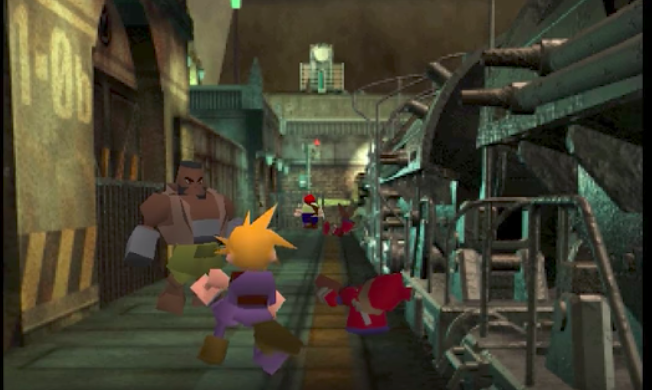
Here, my Vita-loving friend, is your answer: Final Fantasy VII is beloved because it’s weird. Its creative success reveals a truth: That the most successful Japanese role-playing games succeed because they embrace strangeness. The least successful Japanese role-playing games fail because they take themselves too seriously.
In Final Fantasy VII you will go snowboarding, memorise military march choreography, dress up like a sailor, and have disturbing encounters with burly men at a seedy brothel. You will chase a giant stuffed animal around a flying casino. You will settle a climactic showdown with a slap-fight atop a giant cannon.
Whereas Final Fantasy VI took goofy characters and put them in serious situations, Final Fantasy VII takes serious characters and puts them into goofy situations. Both approaches work well, albeit in different ways. In FFVII‘s case, the oddball minigames and wacky scenarios make a welcome contrast to an otherwise dreary plot.
Final Fantasy VII has a fun combat system, a masterful soundtrack, a cast of interesting characters, and all sorts of cool secrets and things to do. Those are all ordinary and understandable reasons to consider a game good. But the reason it is widely considered to be one of the greatest RPGs of all time is because it is weird as hell.
The story: Cloud, a hard-arse mercenary, joins a group of eco-terrorists called Avalanche (led by a walking stereotype named Barret) to fight against the evil energy company Shinra in the enormous, segregated city of Midgar. After bombing some reactors and making a few new friends, Cloud leads his crew to an infiltration of Shinra HQ, where they discover that a warrior named Sephiroth has killed the company’s president.
Cloud and friends chase Sephiroth around the world, eventually discovering that he plans to destroy the planet by summoning a massive meteor called Meteor. Everything falls apart in the world’s northernmost continent, the so-called Promised Land, where Sephiroth murders Cloud’s buddy/possible love interest Aeris and then convinces Cloud that he’s a clone.
Cloud isn’t a clone, it turns out — he just somehow absorbed the memories of his best friend Zack, then built a false persona for himself. Anyway, after more shenanigans, Cloud and the rest of his squad descend into the planet’s core and defeat both Sephiroth and his alien mother, Jenova. (Long story.)
Although they’re able to stop Meteor, it appears to wipe out the planet anyway, and at the end of the game the only survivor we see is Red XIII, a dog who gains strength from his hairpins. (Final Fantasy VII: Advent Children, a film released in 2005, retcons this ending, but we won’t get into that.)
That’s the (extremely) abridged version. There are also various storylines involving Barret and his adopted daughter, an evil doctor named Hojo, an abusive rocket scientist named Cid, a kleptomaniac ninja named Yuffie, a stuffed animal spy named Cait Sith, and Vincent, a clerk at Hot Topic. It’s a multifaceted story that goes in some interesting directions and is generally very good.
The main villain: Most people associate Final Fantasy VII with Sephiroth, and for good reason — he’s a badass bishounen with a giant sword. But the game’s real villain is Jenova, a space alien whose only purpose is to destroy all life on any planet it contacts. (Most of the time, when you see Sephiroth, you’re actually seeing one of Jenova’s projections.) Jenova is bad news. Even her blood cells have unimaginable power.
The gimmick: Final Fantasy VII‘s central mechanic is called the materia system. As you wander around the world, you’ll collect crystals called materia, each with its own spell or ability. There are magic materia (Fire/Ice/Lightning/etc.), summon materia (Shiva/Bahamut/etc.), and specialised materia that will boost your HP or give you automatic counter attacks.
You can combine these materia in all sorts of ways, and naturally, players have figured out how to use them to break the game. For example, via GameFAQs:
WEAPON/ARMOUR: Comet (Level 2)-Quadra Magic, Comet (Level 2)-HP Absorb, Comet (Level 2)-MP Absorb
Comet level 2 hits opponents 4 times. Pack this with a Quadra magic and you have 16 merciless hits that absorb both HP and the MP that was lost in the casting.
Even if you don’t want to turn your characters into death machines, it’s a fun, flexible system that allows for some cool experiments. Also fun: watching the summon animations and thinking about how, just 20 years ago, they blew all of our minds.
Something revolutionary: I believe that Final Fantasy VII is the first game to pull the narrative trick of allowing you to play through a flashback, only for that flashback to turn out to be completely wrong. Early in the game, just after you’ve left Midgar for the first time, you’ll play through Cloud’s memory of his first encounter with Sephiroth.
Later, you’ll find out that it wasn’t actually Cloud in that memory — it was Zack. Cloud was just a masked soldier in the background, hiding his face out of embarrassment that he couldn’t make it into the elite group SOLDIER. Poor guy.
Best cinematic transition: This moment (start at 9:10), which even today looks fantastic:
The saddest death: Cait Sith, who sacrifices himself to save the party from blowing up. He is greatly missed, until his replacement arrives.
The second-saddest death: Yes, yes, I know. It’s hard to talk about Final Fantasy VII without talking about Sephiroth stabbing Aeris through the gut.
There are several good reasons for that. It’s a shocking, well-executed moment that crushes the unsuspecting player not just because Aeris was a sweet girl, but because she was a party member — one who you would never be able to control in combat again. Plus, there’s that music.
Even today, it’s uncommon for a role-playing game to kill off a main character in that way. Designers don’t often like to spend half a game letting the player grow attached to a party member, then rip that party member away. It might infuriate the player, make them stop playing, or, worse, convince them to bring the game to GameStop and trade it in for $US3.50 ($4). Killing Aeris was a bold move, and it had a massive impact on anyone who played Final Fantasy VII before someone could spoil it for them.
Best boss: Jenova LIFE, who pops up right after Aeris’s death. Whereas previous fights against Jenova were scored by her eerie theme song, this battle just keeps playing Aeris’s Theme, which is unsettling.
Here’s the fun part: Jenova LIFE uses nothing but water attacks. And if you were paying attention, you picked up a Water Ring just a few minutes earlier that will protect one of your characters from all water attacks. If you equipped it, there’s no way to lose.
The designers of Final Fantasy VII, knowing that you (and Cloud) are likely still traumatised from Aeris’s untimely death, decide to let you work out your aggression on a boss that can’t beat you. All the while, Aeris’s Theme just continues to play in the background, reminding you of what you just lost. It’s an incredible sequence, and one that stuck with me for a very long time when I first played it.
It’s too bad: The translation is so awful. If the English version of Final Fantasy VII had been written with as much care as, say, Final Fantasy IX a couple years later, it would hold up far better today.
[referenced url=”https://www.kotaku.com.au/2017/08/the-first-few-lines-of-final-fantasy-7-are-a-little-different-in-japanese/” thumb=”https://img.youtube.com/vi/ZefYEaNUJ7w/0.jpg” title=”The First Few Lines Of Final Fantasy 7 Are A Little Different In Japanese” excerpt=”I’m playing Final Fantasy 7 in both English and Japanese at the same time, and noticing a bunch of tiny differences — for you. Here’s a video illustrating what nuances of the first few lines of the game couldn’t make it into the English translation.”]
Best character: Cloud, who starts off as a stereotype (“look at me, I am a badass, look how badass I am”) but gradually evolves over the course of the story in large part because a whole lot of fucked-up things keep happening to him. He is traumatized both physically and mentally throughout the game, and it turns him into a stronger, better person. And therefore a stronger, better character.
Worst character: In retrospect, it’s gotta be Cid, who has a great theme song but is actually an abusive husband!! Cid sucks.
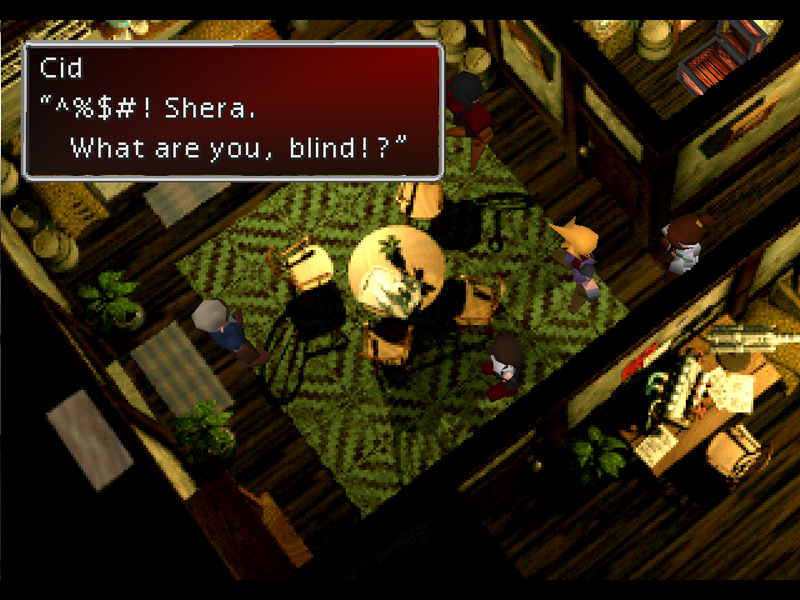
via Elentor/LPArchive
The best dungeon: Shinra HQ, a massive skyscraper that you invade early in Final Fantasy VII. It is still perhaps the only JRPG dungeon that’s set entirely in an office building. For the first 60 floors of Shinra HQ, you can choose to either ride the elevator or walk up 60 flights of stairs, which is just as monotonous as it sounds (yet still somehow satisfying).
Then you get to the upper floors, where you’ll have to solve puzzles and complete minigames, talking to corporate Shinra workers along the way. On the 63rd floor gym, you can go talk to Shinra’s head of security, who doesn’t seem to realise that you’re infiltrating the building he is supposed to secure. Moments like those are what make Final Fantasy VII great.
Fun fact: Aeris’s theme — the iconic piano-heavy song that’s sure to bring a tear to any RPG fan’s eye — is actually a riff on Aria di Mezzo Carattere (aka: the Opera House theme) from Final Fantasy VI.
The best piece of music: This is a really tough one, because Final Fantasy VII‘s soundtrack might be Nobuo Uematsu’s best work. Highwind Takes To The Skies? Cid’s theme? Maybe the main theme? I DON’T KNOW, MAN.
Best summon: Knights of the Round, which makes no sense and takes forever and destroys everything.
Best example of a villain refusing to fight you because he’s busy getting a tan:
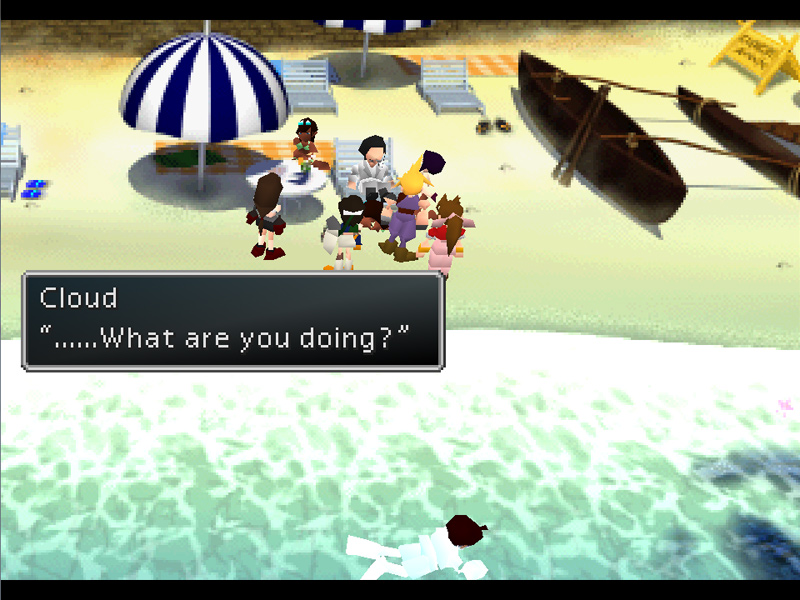
via Elentor/LPArchive
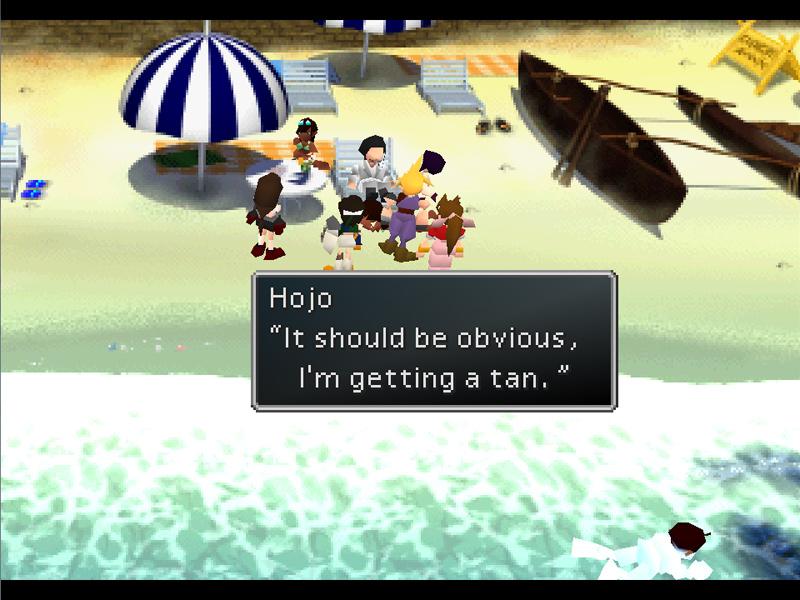
via Elentor/LPArchive
Another fun fact: In the Japanese version of Final Fantasy VII, there’s a hidden boss fight in the bottom of a well in Corel called Test 0, as was described in the Unauthorised Versus strategy guide for Final Fantasy VII. Although Square removed this fight (which seems like a glitch) from the North American version of the game, you can see video of it here:
Yet another fun fact: Back in 1997, there were all sorts of rumours floating around the internet about how you could bring Aeris back to life. Many of them involved getting some sort of elusive materia that would allow you to breathe underwater.
Although none of those rumours were true, many early Final Fantasy VII players didn’t realise that you can actually get a piece of materia that allows you to breathe underwater, by doing a sidequest for an NPC in Kalm. This materia removes the time limit for the ultra-hard Emerald Weapon boss, making him significantly less unpleasant.
Best character who is never explained and does nothing but still gets screen time for some reason: Johnny
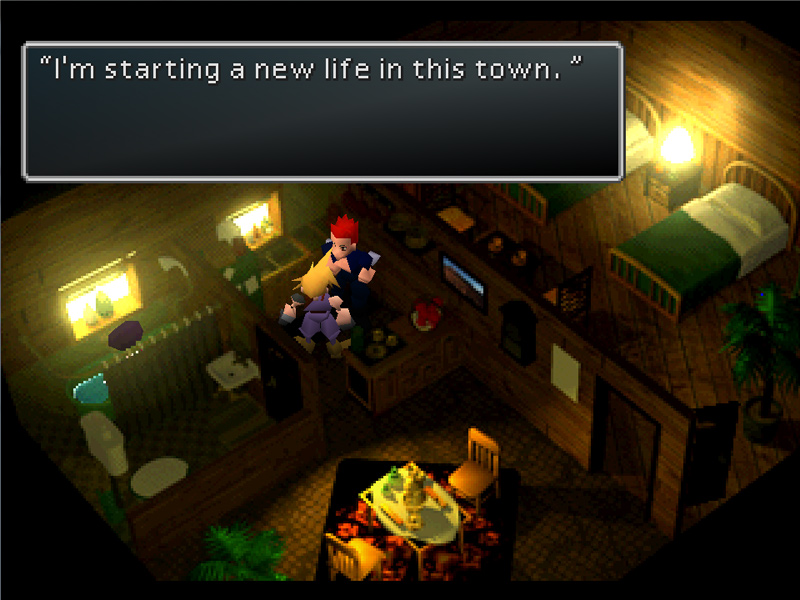
via Elentor/LPArchive
Does the game still hold up? It does. Final Fantasy VII‘s MIND-BLOWING GRAPHICS haven’t aged nearly as well as its 16-bit predecessors, but the game still has panache, and all of that charming weirdness is just as appealing today as it was in 1997. When I play it today, I can understand why people thought it was so special, even when I’m holding back a chuckle while watching Cloud gesticulate with his goofy blocky arms.
Next time: Floating schools and mopy teens…
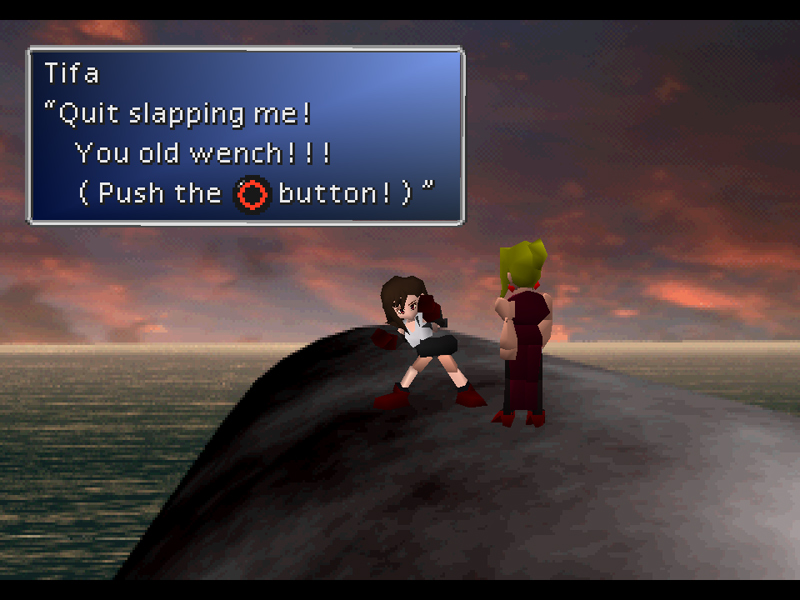
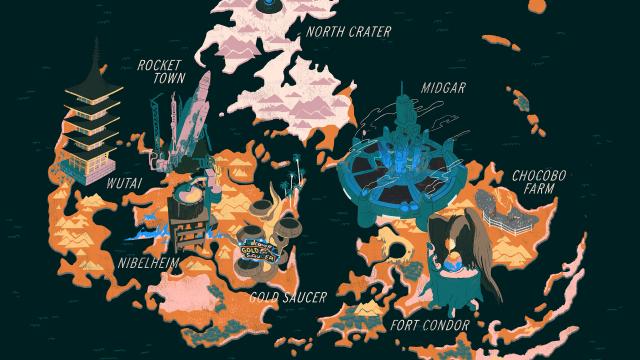
Comments
12 responses to “Final Fantasy 7Â Retrospective: Great Because It’s Weird”
Although they’re able to stop Meteor, it appears to wipe out the planet anyway, and at the end of the game the only survivor we see is Red XIII, a dog who gains strength from his hairpins.
Are you sure about this? That cutscene is 500 years after the event of the game. It still easily allows for nature to take over again after all of the characters we know have died off normally excluding Red XIII
Agreed. I always interpreted the end scene as most of the people having survived but over time abandoned Midgar perhaps due to damage, materia/energy contamination or just their society going back to nature. The final scene is then Red XII showing his kids where it all happened.
The thing I wanted to know in the end scene was how he got the kids, pretty sure when you first meet him it’s stated he is the last of his species.
Wish I still had a copy, somehow I’ve wound up with 2x FF8 but my 7 is gone and the Steam version doesn’t mesh with my nostalgia for a PSX controller.
Yep, it is really strange that the author doesn’t seem to get it since it was, really, the culmination of all the plot points. Yes, Holy ends up being insufficient to stop Meteor, but we clearly can see the lifestream surging up to reinforce Holy. The whole point of the game is that humans (and Jenova) had been harming the planet to exploit its life blood so the planet had all the reasons to want to wipe out humanity (hence the Weapons) but in the end, due to the actions of our heroes, the planet decides to give them another chance by saving them from Meteor.
I have fond memories of sitting down for Final Fantasy VII marathons in early 1999 (I was a little late to the party) with a cup of piping hot GODDAMN TEEAAAA!
All joking aside, I had an amazing time with this game that year. I always found the scene with Red XIII’s father after the cave of the Gi to be as emotional as Aeris’ death. The music alone gets me every time.
Unpopular opinion: 8 was better. Even with the emo melodrama. The music probably helps. Definitely a better soundtrack. Balamb garden theme is permanently recorded in me.
FF8 had a completely different vibe but for me the two games are definitely the peak of the franchise. FF8 had this tone or at least a feeling that it evoked in me at the start of the game especially that I can’t seem to put my finger on. I loved that whole “battle universities” concept and the visual style of those areas.
I think Final Fantasy 7’s soundtrack is consistently awesome, whereas FF8 had a some really awesome songs but some forgettable ones too.
FF8 has very unfairly judged in recent years. (When it was released, all of the reviews pretty much claimed it improved on FF7 in every way) Whether or not you identify with the characters and plot is a personal experience I suppose, but I found FF8 to be much more coherent, have more interesting characters, and a hugely improved soundtrack. (Just compare the instrumental sampling between the two!) FF7 is still awesome, but so is FF8.
I think 8 has stronger strengths and weaker weaknesses. Great visuals, interesting design and worldbuilding are all held ransom by the godawful Junction system.
The towns and NPCs in 8 feel much more real, and triple triad is a top notch minigame.
I definitely enjoyed it best when I wasn’t doing anything combat related. Scaling enemies was an ambitious idea, that unfortunately made leveling up feel like a punishment.
I thought the junction system was bizarre and awesome. I wish the new games took risks like that. It felt balanced between not letting you rely too much on the strongest spells but also turning a blind eye to you manipulating it for your own benefit.
I feel like FF8’s system put a lot of trust in the player to have the kind of fun they wanted to have with it.
I have to agree here : to me, 7 and 8 were the pinnacle of the series thus far. I could never get far into 9 for whatever reason, by the end of 10 i was just over it and couldnt even be bothered beating Sin! 12 was good but not great, never played 13 because the reviews were shocking and 15 was a bit of a mess, although i found it had a great ff vibe to it. By the end though, the fact you couldnt control your team mates in combat really put me off completing all the endgame content unfortunately.
7 was the first rpg i ever got into and i will never forget staying up all night after renting it and all my mates had gone to sleep. Id just gotten out of midgar and the world map blew me away. I remember saving up my pocket money every week to buy it and one week my awesome mum surprised me by buying it early.
I didnt get to 8 until it had been out a fair while, but ended up getting hooked hard on it too, even tho i only beat it twice compared to six or so times for 7. When i think about those times in my life now – i was a teen – it fills me with all sorts of nostalgia, and i get very melancholic. The music in both games was phenomenal and this is undoubtedly a huge factor in my love for these games.
Bloody great times.
As a transitional game from the 2d to 3d era they threw a lot of shit at the wall and much of it stuck. I felt it kept the charm of the 2d era, something later games and extended universe stuff didn’t.
FFVI is my favourite FF and indeed, one of my favourite games ever. When FFVII came out, I instinctively hated it. I hated the replacement of charming 16-bit sprites with blocky, malformed polygons. I hated that Cloud, an aloof and bland jerk was my avatar in the game. I hated him even more when it was revealed that whatever little personality he had, he had lifted from a clearly superior character and I hated him for crumbling down at that revelation and the possibility of being a Jenova clone. I hated the other one-dimensional characters and although I was impacted by Aeris’s death, I still thought it was a less shocking development than, say, the “end” of the world in FFVI or Crono’s death in CT. Even after I finished the game I kept feeling like that for a good while (mostly to fuel my Internet arguments back in the day about why FFVI was clearly superior).
However, through the years, that petty spite and unnecessary comparison to other games have faded out and I’ve found out that what is left is legitimate fondness and appreciation for its actual virtues. As much as I hated Cloud back, now I can appreciate the arc of his character. It is clear to me now that his fastidious facsimile personality was the result of immense physical, mental and emotional strain, that his breakdown an important and necessary reset and more importantly, how he didn’t just go back to his old, real self (a somewhat arrogant country boy whose major goal was to impress a girl) but that he actually build from all the bits and pieces from his fractured life a better self, one that was truly heroic.
The game is also filled with truly iconic and awesome moments, such as Tifa’s stepping up when Cloud was believed dead, and then when she found him comatose, she decided to stay behind to care for him, and later helping him get out of his coma by diving into his subconscious. The story itself is super well articulated and there’s lots of lore to discover and a couple really good plot twists. Oh and the ending is really great and satisfying.
I still don’t love the graphics, but have gained for them the fondness of familiarity and nostalgia, and really, would not change them now even for 16-bit sprites. I can genuinely say that I love FFVII (though, still, not as much as I love FVI).